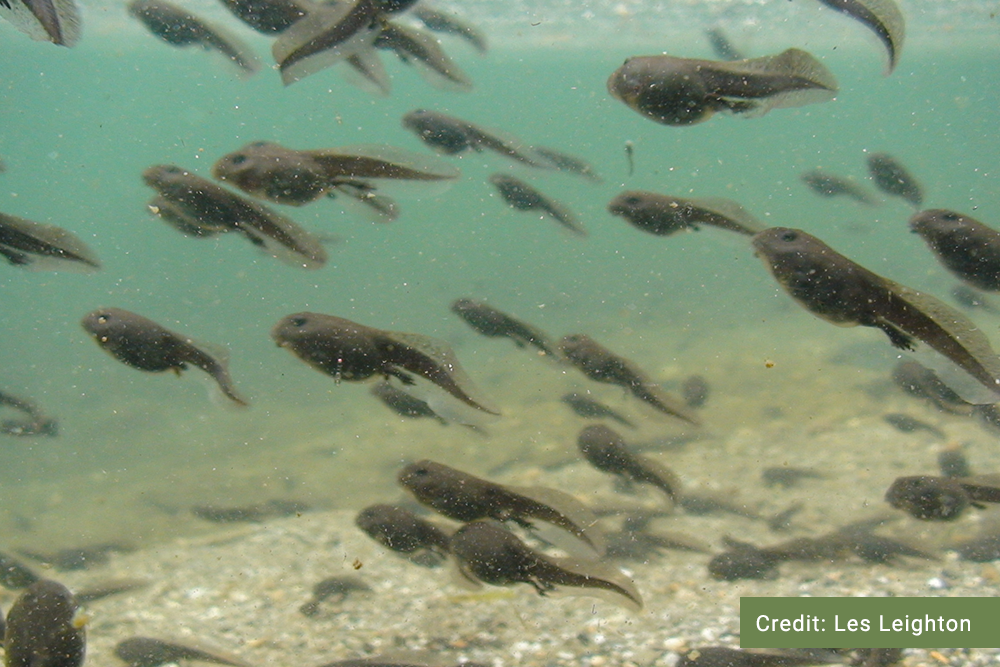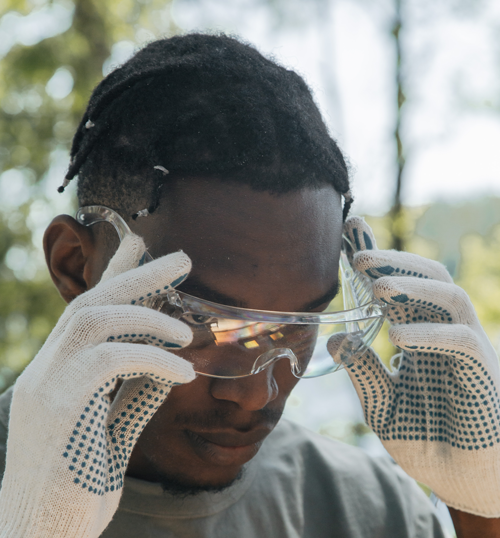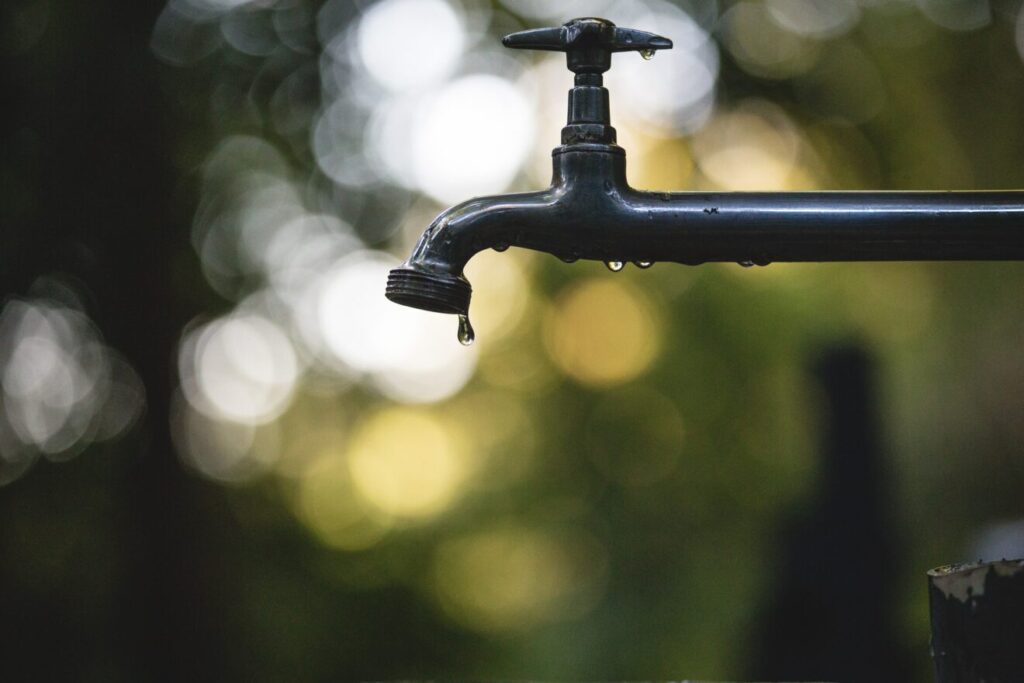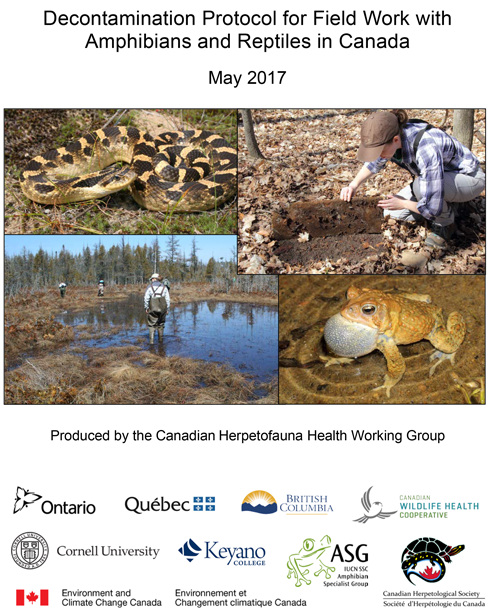Equipment Decontamination Protocol
Why?
Decontaminating equipment is important to prevent the spread of wildlife pathogens and assist in maintaining healthy amphibian and reptile populations in not only British Columbia (B.C.), but the rest of Canada and the United States. There are a number of amphibian and reptile pathogens that may affect species in B.C. Using proper decontamination protocol for field research and recreational equipment will help to keep wildlife populations healthy by ensuring that pathogens are not transported between sites.
When?
Equipment should always be disinfected between sites, particularly when working with at risk populations or at a location with an ongoing mortality event. The definition of a site may vary with the scale of the project, the geography of the area, and the ecological communities.

In aquatic environments, the following are considered separate sites:
- Wetlands, ponds, lakes, or other water bodies that are separated by terrestrial areas
- Each tributary of a river or a stream
- Each upstream location within a river or a stream; it is not necessary to decontaminate between each location when working in rivers or streams that follows a downstream direction

In terrestrial environments, the following are considered separate sites:
- Areas that are divided by major geographical barriers (e.g. lakes or large rivers, cliffs, major highways)
- Areas that are separated by more than 1 km of unsuitable habitat (e.g. agricultural land, urban settlements) or 3 km of suitable habitat (e.g. naturally occurring habitats that are permeable to movement by amphibian and reptile species).
Remember
Within a site, it is recommended that nitrile gloves and other equipment (e.g. measuring tools) be changed or disinfected between handling individual animals, unless those animals have already been in close contact with each other (e.g. in the same pitfall trap). If gloves are not being worn, hands should be washed and disinfected between individuals (note: gloves should always be worn when handling amphibians to protect their sensitive skin from chemicals, oil, and sweat on your hands).
Materials
- Commercial household bleach: example, Clorox Bleach (active ingredient 4-6% sodium hypochlorite)
- Biodegradable soap
- Large bucket or tote that will hold about 25 litres (Rubbermaid totes work well)
- Bucket or container with water-tight lid
- Container with tap water
- Spray bottles
- Scrub brushes
- Dishwashing gloves and safety glasses
Why use bleach for decontamination?
This decontamination protocol recommends bleach as a disinfectant for several reasons:
- It is effective
- It is readily available
- It breaks down relatively quickly and poses lower risk to the environment than some other disinfectants
Steps for Decontamination

- Before you travel to your research site, ensure all your equipment has been decontaminated.
- When you first arrive at the research site, identify a sunny location away from surface water (ponds, streams, ditches, etc.) that has an asphalt or hard-packed surface (e.g. a parking lot). This location will be your decontamination area after you finish your work. The direct sunlight will help break down the bleach before it can enter surface waters.

- After you complete your work, return to your decontamination area and clean all equipment with tap water (do not rinse with water from a local pond, lake, etc.), using a scrub brush to remove organic material (mud or vegetation) from your boots and other equipment. If done for the day, thoroughly wash equipment with soapy water and rinse with clean tap water.
- Put on safety glasses and make your decontamination solution in a large bucket/tote by adding 1 part bleach to 19 parts water (e.g. add approximately 1 litre of bleach to 19 litres of tap water, or for smaller batches, 50 ml of bleach to 950 ml of water).

- Immerse equipment (including scrub brushes) in the bleach solution. Use a spray bottle to soak larger items thoroughly. Soak equipment for five minutes.
- For sensitive equipment like calipers, cameras, electronic scales, etc., rinse or wipe with 70% ethanol.
- Rinse the bleached items with clean tap water to prevent exposing the next site to residual bleach and to minimize damage to equipment. If clean tap water is not available, rinse the bleached items with water from the next site (away from aquatic habitats). Do not rinse with water from the current site. If you are done for the day, allow the equipment to dry completely.

- Whenever possible, remove the bleach solution and soapy water from the site using a bucket with a water-tight lid and dispose of them appropriately. Otherwise, dispose of them at the decontamination site (note: these solutions should not be disposed of in the field if it is raining or if a suitable decontamination area is not available). Ensure full compliance with local laws and safe disposal regulations.
- Once home, wash clothing in hot water.

Additional Resources
Decontamination Protocol for Field Work with Amphibians and Reptiles in Canada
Other considerations:
- See manufacturer’s recommendations and Material Safety Data Sheet requirements for safe handling and disposal of bleach and ethanol.
- Bleach and ethanol can be fatal to amphibians and reptiles, so ensure that these chemicals are kept away from these animals and their habitats.
- If it is not possible or safe to decontaminate with bleach at a site, rinse and/or wash your equipment, seal it in a garbage bag and decontaminate off site.
- As an alternative to decontaminating all equipment between sites, pack separate sets of equipment for each site.
- Select footwear that is easy to clean and can be submerged in bleach solution (i.e. rubber boots).
